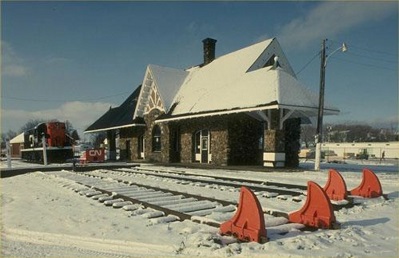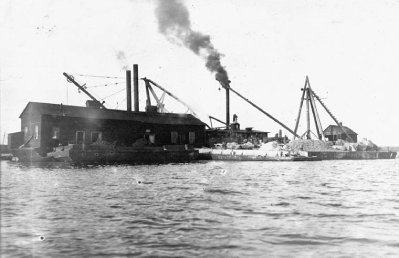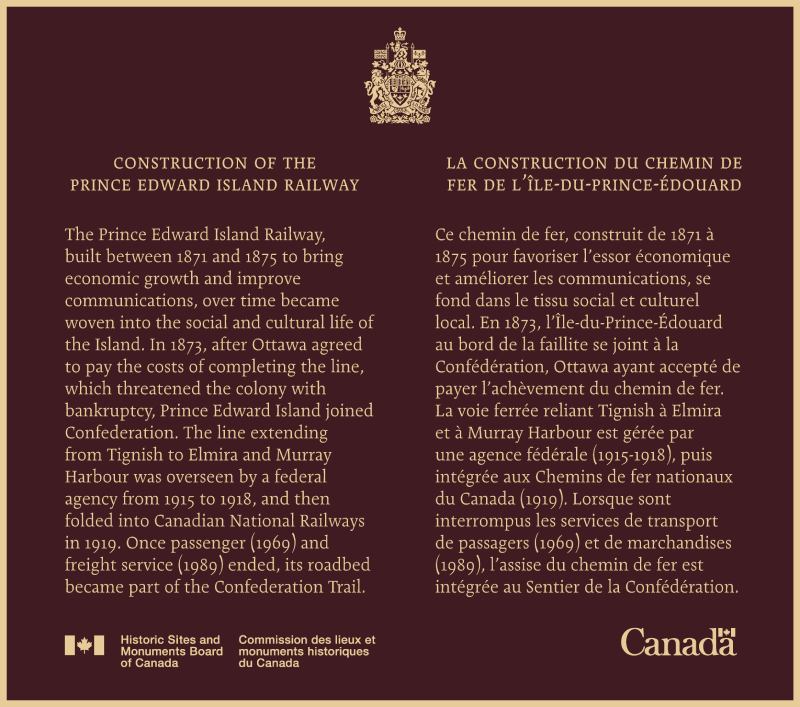Construction of the Prince Edward Island Railway National Historic Event

© Parks Canada
The construction of the Prince Edward Island Railway was designated as a national historic event in 2018.
Historical importance: major political and railway engineering achievement in Canada.
Commemorative plaque: will be installed at 6 Prince Street, Founders’ Hall, Charlottetown, Prince Edward IslandFootnote 1
Construction of the Prince Edward Island Railway
The Prince Edward Island Railway, built between 1871 and 1875 to bring economic growth and improve communications, over time became woven into the social and cultural life of the Island. In 1873, after Ottawa agreed to pay the costs of completing the line, which threatened the colony with bankruptcy, Prince Edward Island joined Confederation. The line extending from Tignish to Elmira and Murray Harbour was overseen by a federal agency from 1915 to 1918, and then folded into Canadian National Railways in 1919. Once passenger (1969) and freight service (1989) ended, its roadbed became part of the Confederation Trail.
The construction of the Prince Edward Island Railway
The construction of the Prince Edward Island Railway between 1871 and 1875 created a transportation link across the Island that stimulated employment, contributed to the social and cultural life of Islanders, and generated economic and commercial opportunities. Its construction led to a $3.25 million debt, which was staggering for the colony at the time and played a significant role in bringing Prince Edward Island into Confederation.

© Coleman, H.T. / Library and Archives Canada / PA-021819
Prince Edward Island’s road to Confederation dates back to 1864 when delegates from Nova Scotia, New Brunswick, and Prince Edward Island agreed to meet in Charlottetown to discuss the possibility of union. They were joined by a contingent from the Province of Canada that wished to broaden the scope of discussions to include a union of all British North American colonies. Prince Edward Island had a strong identity and a successful economy, and there were concerns that union would not bring any immediate benefits to the Island. Opponents argued that with Confederation, taxes would increase, local needs and concerns would not be addressed in a federal parliament, and the long-standing issue of absentee landownership on the Island would remain unresolved. Prince Edward Island did not join Confederation on 1 July 1867.
In 1871, Prince Edward Island began construction of a railway which it hoped would improve the Island’s economy and increase leisure travel. The Prince Edward Island Railway was a narrow-gauge railway, built under the supervision of Chief Engineer John Edward Boyd. Poorly planned from the outset, the project quickly exceeded its budget. The government failed to stipulate either the length or route of the railway and, as a result, lobbyists attempted to bribe politicians to locate stations within their own communities. The government had also agreed to pay a fixed cost per mile but neglected to put a limit on the number of miles to be built. Consequently, the contractors—not the government—had full control over construction. By 1872, the railway had put the colony on the verge of economic collapse. In need of help, Prince Edward Island approached the Dominion government about joining Confederation. Canada assumed the Island’s railway debt as part of the negotiations, and Prince Edward Island joined Canada on 1 July 1873.

Largely completed by 1875, the railway was a major employer and further benefitted the province by cutting overland transportation costs, thus opening up the interior for development. It was operated by a federal agency and amalgamated into the Canadian National Railways in 1919. Running from Tignish in the west, to Elmira in the east, and Murray Harbour in the southeast, the railway was an important link between communities, not only for locals but also for an increasing number of tourists. The railway was heavily used during the Second World War (1939–1945) but then saw declining use as cars became more common and passenger trains on the Island ceased to run in 1969. Freight operations too gave way to trucks and in 1989, the railway system was abandoned. Equipment was removed and the infrastructure was dismantled. In 1994, the railway lands were turned over to the province and its Rails to Trails program resurrected the rail bed as a recreational pathway called the Confederation Trail.
Epekwitk (Prince Edward Island) is the traditional territory of the Mi’kmaq, who were excluded from discussions regarding Confederation, land tenure on the Island, and the construction of the railway.
This press backgrounder was prepared at the time of the plaque unveiling in 2024.
The National Program of Historical Commemoration relies on the participation of Canadians in the identification of places, events and persons of national historic significance. Any member of the public can nominate a topic for consideration by the Historic Sites and Monuments Board of Canada.
- Date modified :